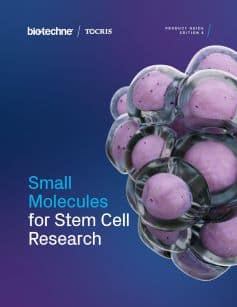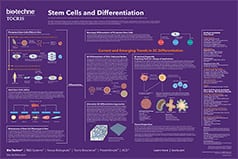Stem Cells
Stem cells are unspecialized cells that are capable of self-renewal through mitotic cell division, even after long periods of inactivity. Stem cells may be induced to form more specialized cells of a tissue or organ by a process termed cellular differentiation, which is defined by the potency of a cell.
Stem Cell Target Files
Related Targets
Owing to their regenerative potential, stem cells in some tissues and organs are utilized to repair or replace old or damaged cells and this property may be useful in regenerative medicine. In other tissues such as the heart, this does not occur and stem cells only divide under strict conditions.
The four main types of stem cells are: embryonic stem cells (ESCs) found in the inner cell mass of blastocysts; adult (or somatic) stem cells, found in adult tissues and responsible for maintenance and repopulation of specific cell types; induced pluripotent stem cells (iPSCs), produced by the reprogramming of somatic cells; and cancer stem cells (CSCs).
Stem cells offer the potential for treating many diseases including cancer and neurodegenerative conditions, such as Parkinson's disease or Huntington's disease, or nerve damage due to trauma.
Resources for Stem Cell Research
Blog Post: Regenerative Medicine - From Bench to Clinic
Regenerative medicine is the repair or replacement of damaged or diseased tissue to restore normal tissue function. This blog post discusses the development of a new cell therapy product derived from PSCs for regenerative medicine use in Parkinson's disease.
Read Now!Stem Cell Protocols
Our protocol snapshots highlight how small molecules may be used in the stem cell workflow for maintenance, reprogramming and differentiation.
Browse ProtocolsBlog post: Cerebral Organoids for Neurodevelopment, Neurodegeneration & Virology Research
When derived from human cells, cerebral organoids enable the investigation of neurophysiology and disease using in vitro and in vivo methods that cannot be used in humans. This blog post describes how cerebral organoids can be used in neurodevelopment, neurodegeneration and virology research.
Read Now!Blog Post: New Uses for Organoids
Organoids are stem cell-derived self-assembling 3D structures that are useful in advancing our understanding of the biology of complex systems. This blog post outlines the use of organoids in medicine and drug development.
Read Now!Blog Post: Cryopreservation of Stem Cells with the ROCK Inhibitor
Cryopreservation for storage of cells is a key step in stem cell protocols. The ROCK inhibitor Y-27632 improves post-thaw survival rates. This blog post outlines how this compound protects stem cells from dissociated-associated apoptosis.
Read Now!Blog Post: GMP Ancillary Materials for Stem Cell Therapy Manufacture
Stem cell therapies have the potential to treat several diseases, and these therapies are now entering clinical trials and approaching the clinic. This blog discusses small molecules as an ancillary material (AMs) for stem cell therapy manufacture, including their advantages over other types of AMs.
Read Now!Blog Post: Small Molecules in Stem Cell Research
Small molecules are increasingly being used alone, or in combination with growth factors, to modulate stem cells. They can be used at all stages of the stem cell workflow, i.e. in reprogramming, maintenance, storage and differentiation protocols. This blog post outlines the advantages of using small molecules.
Read Now!Related Product From Bio-Techne
View all pluripotent stem cell resources available from Bio-Techne.
Literature for Stem Cells
Tocris offers the following scientific literature for Stem Cells to showcase our products. We invite you to request* your copy today!
*Please note that Tocris will only send literature to established scientific business / institute addresses.
Stem Cells Scientific Review
Written by Kirsty E. Clarke, Victoria B. Christie, Andy Whiting and Stefan A. Przyborski, this review provides an overview of the use of small molecules in the control of stem cell growth and differentiation. Key signaling pathways are highlighted, and the regulation of ES cell self-renewal and somatic cell reprogramming is discussed. Compounds available from Tocris are listed.
Stem Cell Workflow Poster
Stem cells have potential as a source of cells and tissues for research and treatment of disease. This poster summarizes some key protocols demonstrating the use of small molecules across the stem cell workflow, from reprogramming, through self-renewal, storage and differentiation to verification. Advantages of using small molecules are also highlighted.













